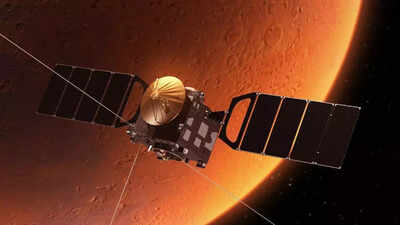- News
- Science News
- How Mangalyaan-2 will land on Mars: ISRO chief reveals plan
How Mangalyaan-2 will land on Mars: ISRO chief reveals plan
India is preparing for Mangalyaan-2, a follow-up to its successful Mars Orbiter Mission. ISRO plans to achieve a historic first by landing a spacecraft on Mars. The mission involves a direct entry into the Martian atmosphere, utilizing advanced technologies for a safe touchdown. A mini-helicopter will also be deployed to survey the landscape, expanding exploration capabilities.
India is gearing up for a major leap in planetary exploration with Mangalyaan-2, its second mission to Mars. The Indian Space Research Organisation (ISRO) has revealed an ambitious plan to land a spacecraft on Mars’ surface. This will be a first for the country.
This mission builds on the success of Mangalyaan-1 (Mars Orbiter Mission), which was launched in 2013 and became the first Indian spacecraft to reach Mars. Remarkably, it achieved this feat on its maiden attempt. Mangalyaan-1 exceeded expectations by functioning for over eight years, far beyond its original six-month mission life.
How Mangalyaan 2 will complete its touchdown in extreme conditions: From launching to landing
According to ISRO Chief Dr. V. Narayanan, Mangalyaan-2 will be launched aboard the powerful LVM3 rocket and placed in an elliptical Earth orbit of 190 x 35,786 km. The spacecraft, weighing around 4,500 kg, is made up of two main components: the Cruise Stage and the Descent Stage. The Cruise Stage is responsible for powering and navigating the spacecraft during its long journey through space. It contains the engines, solar panels, communication systems, and other support equipment needed to keep the mission on track while travelling from Earth to Mars. Attached to it is the Descent Stage, which contains the lander and is designed specifically for the final phase of the mission.
As the Descent Stage enters the thin Martian atmosphere, which is about 100 times thinner than Earth’s, it will face what NASA calls the "seven minutes of terror," a crucial period during which the spacecraft must survive intense heat, high speeds, and rapidly changing conditions. The landing sequence will begin with aerobraking to slow the spacecraft using atmospheric drag, followed by the deployment of supersonic parachutes and a heat-resistant aeroshell to further reduce speed and shield the lander. At an altitude of approximately 1.3 kilometres above the Martian surface, powered descent engines will ignite and carefully control the final approach, guiding the lander to a safe and precise touchdown.
Helicopter to survey the Martian land
A standout feature of Mangalyaan-2 is the inclusion of a mini helicopter, inspired by NASA’s successful Ingenuity drone. This rotorcraft will enable India to explore the Martian terrain from the air and extend scientific reach beyond the immediate landing site.
The helicopter’s role will be to survey the landscape, assist in navigation, and potentially scout locations for future missions.
Timeline of Mangalyaan 2 mission
Although ISRO has not confirmed an official launch date, the release of such a detailed and forward-looking mission plan signals India’s serious intent to join the elite club of nations that have successfully landed and operated technology on Mars.
Mangalyaan-2 is not just about reaching the Red Planet. It is about landing, exploring, and showcasing India’s technological capabilities in deep space missions.
With this mission, India is set to push the boundaries of what is possible and aims to make history as one of the few countries to land and fly on Mars.
Also Read: Pet dogs harm wildlife, ecosystem and climate; suggests study
End of Article
FOLLOW US ON SOCIAL MEDIA


